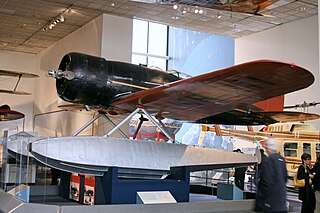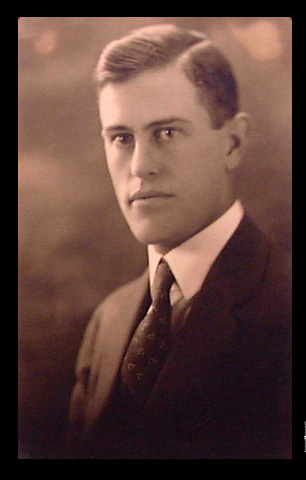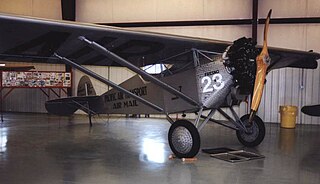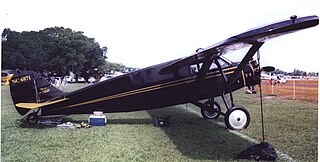
The Spirit of St. Louis is the custom-built, single-engine, single-seat, high-wing monoplane that was flown by Charles Lindbergh on May 20–21, 1927, on the first solo nonstop transatlantic flight from Long Island, New York, to Paris, France, for which Lindbergh won the $25,000 Orteig Prize.
This is a list of aviation-related events from 1928:

The Ryan Aeronautical Company was founded by T. Claude Ryan in San Diego, California, in 1934. It became part of Teledyne in 1969, and of Northrop Grumman when the latter company purchased Ryan in 1999. Ryan built several historically and technically significant aircraft, including four innovative V/STOL designs, but its most successful production aircraft was the Ryan Firebee line of unmanned drones used as target drones and unmanned air vehicles.

Fantasy of Flight is an aviation museum in Polk City, Florida.

The Ryan STs were a series of two seat, low-wing monoplane aircraft built in the United States by the Ryan Aeronautical Company. They were used as sport aircraft, as well as trainers by flying schools and the militaries of several countries.

Tubal Claude Ryan was an American aviator born in Parsons, Kansas. Ryan was best known for founding several airlines and aviation factories.

The Spirit of St. Louis is a 1957 aviation biography film in CinemaScope and Warnercolor from Warner Bros., directed by Billy Wilder, produced by Leland Hayward, and starring James Stewart as Charles Lindbergh. The screenplay was adapted by Charles Lederer, Wendell Mayes, and Billy Wilder from Lindbergh's 1953 autobiographical account of his historic flight, which won the Pulitzer Prize in 1954.

San Diego Air & Space Museum is an aviation and space exploration museum in San Diego, California, United States. The museum is located in Balboa Park and is housed in the former Ford Building, which is listed on the US National Register of Historic Places. SDASM was established by articles of incorporation on October 12, 1961, and opened to the public on February 15, 1963.
Ryan Airline Company was an airline founded by T. Claude Ryan and Benjamin Franklin "Frank" Mahoney at Dutch Flats Airport in San Diego, California, on April 19, 1925. They had earlier established a scheduled service between San Diego and Los Angeles with a fare of $14.50 one-way and $22.50 round-trip.

The Lockheed Model 8 Sirius was a single-engined, propeller-driven monoplane designed and built by Jack Northrop and Gerard Vultee while they were engineers at Lockheed in 1929, at the request of Charles Lindbergh. Two versions of the same basic design were built for the United States Air Force, one made largely of wood with a fixed landing gear, and one with a metal skin and retractable landing gear, designated Y1C-25 and Y1C-23, respectively. Its basic role was intended to be as a utility transport.

The EAA Aviation Museum, formerly the EAA AirVenture Museum, is a museum dedicated to the preservation and display of historic and experimental aircraft as well as antiques, classics, and warbirds. The museum is located in Oshkosh, Wisconsin, United States, adjacent to Wittman Regional Airport, home of the museum's sponsoring organization, the Experimental Aircraft Association (EAA), and the organization's EAA AirVenture Oshkosh event that takes place in late July/early August.

Donald Albert Hall was an American pioneering aeronautical engineer and aircraft designer who is most famous for having designed the Spirit of St. Louis.

The Wright R-790 Whirlwind was a series of nine-cylinder air-cooled radial aircraft engines built by Wright Aeronautical Corporation, with a total displacement of about 790 cubic inches (12.9 L) and around 200 horsepower (150 kW). These engines were the earliest members of the Wright Whirlwind engine family.

The Ryan M-1 was a mail plane produced in the United States in the 1920s, the first original design built by Ryan. It was a conventional gear parasol-wing monoplane with two open cockpits in tandem and fixed, tailskid undercarriage.

The Ryan C-1 Foursome, also known as the "Baby Brougham" was a single-engine, four-seat light aircraft built by Ryan Aeronautical in the United States in 1930 as an executive transport. It was a high-wing, braced monoplane based on Ryan's highly successful Brougham design, but substantially smaller. The interior was luxuriously furnished, with deeply upholstered seats, and an oversize cabin door was fitted to ease boarding and disembarking for the three passengers.

The Stinson Junior was a high-winged American monoplane of the late 1920s, built for private owners, and was one of the first such designs to feature a fully enclosed cabin.

Lieutenant John Moncrieff and Captain George Hood were two New Zealanders who vanished on 10 January 1928 while attempting the first trans-Tasman flight from Australia to New Zealand. Radio signals were received from their aircraft for 12 hours after their departure from Sydney, but despite a number of purported sightings in New Zealand, and many land searches in the intervening years, no trace of the aviators or their aircraft has ever been found.

The Wright-Bellanca WB-2, was a high wing monoplane aircraft designed by Giuseppe Mario Bellanca, initially for Wright Aeronautical then later Columbia Aircraft Corp.

Robertson Aircraft Corporation was a post-World War I American aviation service company based at the Lambert-St. Louis Flying Field near St. Louis, Missouri, that flew passengers and U.S. Air Mail, gave flying lessons, and performed exhibition flights. It also modified, re-manufactured, and resold surplus military aircraft including Standard J, Curtiss Jenny/Canuck, DeHavilland DH-4, Curtiss Oriole, Spad, Waco, and Travel Air types in addition to Curtiss OX-5 engines.

The Lindbergh Boom (1927–1929) is a period of rapid interest in aviation following the awarding of the Orteig Prize to Charles Lindbergh for his 1927 non-stop solo transatlantic flight in the Spirit of St. Louis. The Lindbergh Boom occurred during the interwar period between World War I and World War II, where aviation development was fueled by commercial interests rather than wartime necessity. During this period, dozens of companies were formed to create airlines, and aircraft for a new age in aviation. Many of the fledgling companies funded by stock went under as quick as they started as the stock that capitalized them plummeted in value following the Wall Street Crash of 1929. The Great Depression dried up the market for new aircraft, causing many aircraft companies to go into bankruptcy or get consolidated by larger entities. Air racing, record attempts, and barnstorming remained popular, as aviators tried to recapture the prizes and publicity of Lindbergh's Transatlantic flight.





















